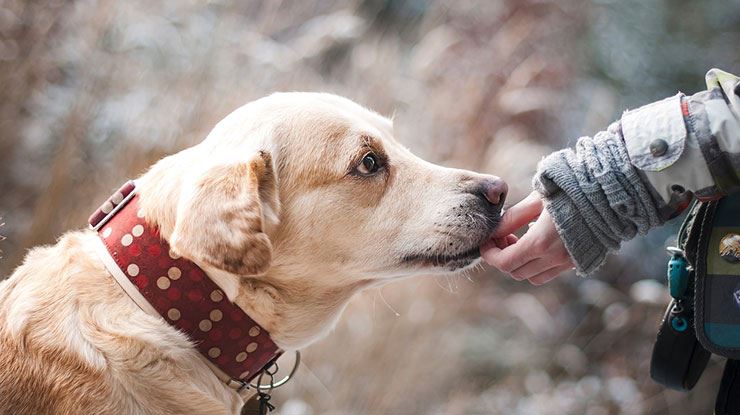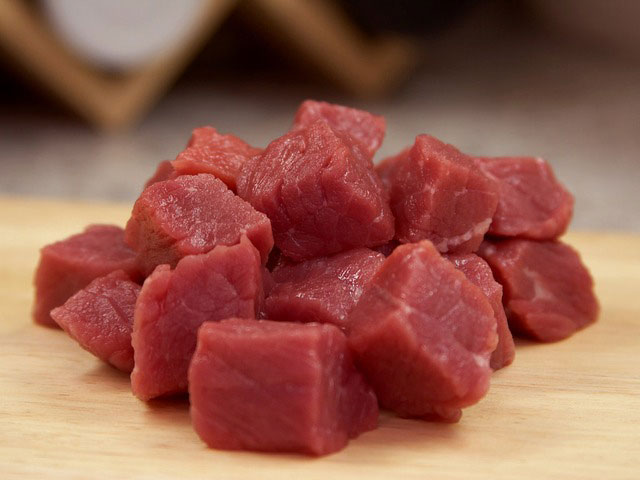
How to Spot a Dog Food Allergy
When your dog is introduced to an allergen, whether through diet or environment, their immune system gets triggered, causing their body to go a little haywire. Until you identify exactly what they’re reacting to, nothing you do will solve the problem.
Without this understanding, pet parents might begin feeding their pup a new dog food that claims to be allergen-free or turn to grain-free dog food, hoping this will ease their discomfort. Unfortunately, it's unlikely that these changes will make a difference.
Grains are rarely the culprit behind food-related issues. It's far more common for pups to react to the meat and dairy proteins in their diet. So, turning to a grain-free dog food will not only fail to remove the allergen but eliminate some of the health benefits that whole grains provide. They're rich in fiber, which supports the large and small bowel, a nutritious source of protein, vitamins, and minerals. They also support the growth of beneficial bacteria in the gut and provide a low-fat, lean protein that can help fortify the other protein sources in your dog's diet.
So, before you change elements of your pup's diet, it's important to work with your veterinarian in diagnosing the underlying issue. It may stem from a completely different health-related issue or something environmental such as pollen, grasses, mold, fleas, and shampoo, to name a few, or a far more common food-related issue, sensitivity (AKA intolerance).
Unlike dog food allergies, a sensitivity isn't an immune response to an ingredient; it's a non-immunologic adverse response to food (usually gastrointestinal) due to an inability to metabolize an ingredient properly.
In fact, ‘true’ dog food allergies are quite rare, but they do happen. And allergies (both diet and environmental) share many of the same symptoms with food sensitivity. So, correctly diagnosing your pup’s issue is a vital first step.
Spotting Common Dog Food Allergy Symptoms
Below are some common dog food allergy symptoms that could point to another ailment, which is why it’s vital to work with your veterinarian to uncover any health issues rather than make sweeping changes to diet and environment in hopes of solving the issue.
Chronic Ear Infections: Frequent ear infections occurring more than 2 or 3 times a year can point to a dog food allergy. While yeast infections and ear mites can cause ear infections, if they persist throughout the year and recur after antibiotics, your pup may have a dog food allergy.
- Spotting an Issue: Stinky ears with black or brown build-up, and excessive head-shaking, ear rubbing, and scratching.
- Other Culprits: Your veterinarian may first rule out ear mites, yeast infection, and swimmer’s ear (dogs who swim are prone to this).
Red, Brown, or Bronze Nail Beds: Your dog’s nails should be white, with a pink quick, but if the base is red, or even bloody-looking, this may be a sign of an inflammatory immune response.
- Spotting an Issue: If your pup is itching or licking their paws often, take a look for the discoloring. Be gentle; their nails may be sensitive.
- Other Culprits: Your veterinarian may first rule out foot injury (trauma) or thyroid disorders.
Bronzing Around the Lips: This can indicate a yeast colonization, often triggered by an allergy.
- Spotting an Issue: This is most noticeable in pups with white or light-colored coats. Their lips, jowls, feet, or skin will look pink and inflamed, and they will itch and scratch excessively.
- Other Culprits: Your veterinarian might first rule out other causes for a yeast-based infection.
Skin, Red Underbelly, and Dull Coat: Together, these signs can indicate a dog food allergy.
- Spotting an Issue: Your dog scratches excessively, often causing hairless patches and irritated areas of skin that are red or pink, dry, and inflamed. Baths and over-the-counter allergy medications don't alleviate the issue.
- Other Culprits: Your veterinarian might first rule out environmental allergies including, fleas, flea allergy, mites, grass, mold, shampoos, and perfumes. It’s important to thoroughly rinse your pup after a bath. Shampoo residue is a leading factor in dermatitis. To be safe, rinse your dog two or even three times.
Watery Eyes: The tear ducts get clogged, due to discharge and inflammation; this may increase tear production to clear the clog.
- Spotting an Issue: Frequently scratching their face and eyes, along with gooey discharge, and watery eyes.
- Other Culprits: Your veterinarian might first rule out environmental allergies including fleas, flea allergy, mites, grass, mold, shampoos, and perfumes.
While these are some of the most common symptoms associated with dog food allergies, your pup may also experience gastrointestinal issues such as diarrhea, vomiting, gas, lack of appetite, and weight loss. And some unlucky pups may experience both skin and gastrointestinal issues.
Now that we’ve covered some common symptoms associated with dog food allergies let’s take a look at which foods commonly cause a food-related, adverse reaction.
Common Culprits of Food Allergies
Often, a reaction to food results from overexposure to an ingredient. If your dog is reacting to an ingredient in their food, there’s a good chance it’s the protein in their diet that’s problematic. And it’s not just meat that’s under scrutiny—some veggies contain protein, so they're not automatically safe.
Top offenders commonly found in dog food:
- Beef
- Dairy Products
- Chicken
- Fish
- Chicken Eggs
A reaction to one animal protein won’t necessarily mean an allergy to other seemingly similar sources. Let’s say your pup reacts to chicken; that doesn’t mean that turkey is automatically off the menu. The least likely, as mentioned earlier, is an allergy to grains or other plant-sourced ingredients.
Once you and your veterinarian have ruled out all other potential causes for your pup’s discomfort, the next step will be identifying the specific food or foods that need to be eliminated from your dog’s diet.
The most accurate way to pinpoint an allergen is through an elimination trial (aka limited-ingredient diet). By placing your pup on a strict diet (including treats, flavored medications, and even flavored toothpaste), you can slowly introduce ingredients back into mealtime while watching for a reaction. There are a few methods for approaching an elimination trial, which your veterinarian will cover with you. But be prepared for the process to take up to 16 weeks to fully stabilize your pup’s system in order to introduce ingredients back in slowly.
Let’s skip forward to the day you’ve finally discovered all the foods your pup is sensitive or allergic to. Now, it’s time to manage their diet.
Managing Your Dog’s Diet
The only sure-fire way to treat a dog food allergy is to remove the allergens from your pup’s diet.
There are a few ways to accomplish this.
- Homemade Diet: You’ll need to consult a pet nutritionist to formulate a balanced and healthy dog food recipe you can follow to ensure the proper balance of protein, calories, carbohydrates, vitamins, and minerals.
- Customized Dog Food: Select a company that specializes in producing high-quality personalized dog food. This is the simplest way to ensure your pup’s specific sensitivities and dietary restrictions are being addressed.
- Pet Store Run: If you’d rather stick to your favorite pet food supply store, that’s fine. Just be sure to review the ingredients carefully. If the label is unclear, contact the company and double-check. If you don’t get clarity, don’t purchase that food. You may inadvertently serve your dog something they are allergic to. And for sensitive pups, it only takes a small amount of the allergen to cause a reaction.
Identifying what your dog is allergic to may seem like a big undertaking, but it’s well worth the effort. A balanced nutrition is one of the most important contributors to a healthy life. And your dog will be so much happier when they aren’t itching and chewing all day.
Dr. Laura Duclos leads the Research and Development team at Puppo. She has over 16 years of experience in developing nutritional pet food that supports animal health and wellbeing. Her clinical research has been featured in prominent publications and scientific journals. She has been an invited speaker at numerous international veterinary conferences on pet nutrition and innovation.










